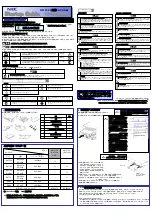
5.2Manual adjusting function
5-45
Usage example of velocity feed forward
The velocity feed forward will become effective as the velocity feed forward gain is gradually increased
with the velocity feed forward filter set at approx. 50 (0.5 ms). The positional deviation during operation at
a constant velocity is reduced as shown in the equation below in proportion to the value of velocity feed
forward gain.
Positional deviation [unit of
command] =
command velocity [unit of command/s] / positional loop
gain [1/s] x (100
–velocity feed forward gain [%]) / 100
With the gain set at 100%, calculatory positional deviation is 0, but significant overshoot occurs during
acceleration/deceleration.
If the updating cycle of the positional command input is longer than the driver module control cycle, or
the pulse frequency varies, the operating noise may increase while the velocity feed forward is active. If
this is the case, use positional command filter (1st delay or FIR smoothing), or increase the velocity
forward filter setup value.
Usage example of torque feed forward
To use the torque feed forward, correctly set the inertia ratio. Use the value that was determined at the
start of the Real-time auto tuning, or set the inertia ratio that can be calculated from the machine
specification to Pr 0.04 Inertia ratio.
The torque feed forward will become effective as the torque feed forward gain is gradually increased
with the torque feed forward filter is set at approx. 50 (0.5 ms).
Positional deviation at a constant acceleration/deceleration can be minimized close to 0 by increasing
the torque forward gain. This means that positional deviation can be maintained at near 0 over entire
operation range while driving in trapezoidal speed pattern under ideal condition where disturbance torque
is not active.
Zero positional deviation is impossible in actual situation because of disturbance torque.
As with the velocity feed forward, large torque feed forward filter time constant decreases the operating
noise but increases positional deviation at acceleration change point.
Summary of Contents for MINAS A6 Series
Page 10: ...Table of contents x Blank page...
Page 11: ...1 Introduction...
Page 26: ...Introduction 1 16 Blank page...
Page 27: ...2 Interface Specifications...
Page 46: ...Interface Specifications 2 20 Blank page...
Page 47: ...3 Front Panel Specifications...
Page 57: ...4 Basic Functions...
Page 85: ...5 Auto Tuning Functions...
Page 151: ...6 Application Functions...
Page 185: ...7 Protective Functions...
Page 224: ...Protective Functions 7 40 Blank page...
Page 225: ...8 Advanced Safety Functions...
Page 230: ...Advanced Safety Functions 8 6 When test pulse is used Duplex safety input Safety input...
Page 245: ...9 List of Parameters...
Page 281: ...10 Timing Chart...
Page 290: ...Timing Chart 10 10 Blank page...
Page 291: ...11 Power Supply Module...















































